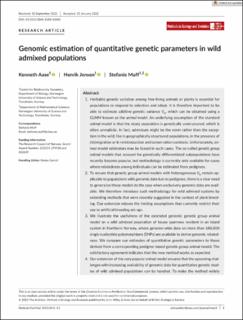| dc.contributor.author | Aase, Kenneth | |
| dc.contributor.author | Jensen, Henrik | |
| dc.contributor.author | Muff, Stefanie | |
| dc.date.accessioned | 2023-01-23T15:04:16Z | |
| dc.date.available | 2023-01-23T15:04:16Z | |
| dc.date.created | 2022-05-05T10:34:22Z | |
| dc.date.issued | 2022 | |
| dc.identifier.citation | Methods in Ecology and Evolution. 2022, 13 (5), 1014-1026. | en_US |
| dc.identifier.issn | 2041-210X | |
| dc.identifier.uri | https://hdl.handle.net/11250/3045449 | |
| dc.description.abstract | 1. Heritable genetic variation among free-living animals or plants is essential for populations to respond to selection and adapt. It is therefore important to be able to estimate additive genetic variance VA, which can be obtained using a GLMM known as the animal model. An underlying assumption of the standard animal model is that the study population is genetically unstructured, which is often unrealistic. In fact, admixture might be the norm rather than the exception in the wild, like in geographically structured populations, in the presence of (im)migration or in reintroduction and conservation contexts. Unfortunately, animal model estimators may be biased in such cases. The so-called genetic group animal models that account for genetically differentiated subpopulations have recently become popular, but methodology is currently only available for cases where relatedness among individuals can be estimated from pedigrees.
2. To ensure that genetic group animal models with heterogeneous VA remain applicable to populations with genomic data but no pedigrees, there is a clear need to generalize these models to the case when exclusively genomic data are available. We therefore introduce such methodology for wild admixed systems by extending methods that were recently suggested in the context of plant breeding. Our extension relaxes the limiting assumptions that currently restrict their use to artificial breeding set-ups.
3. We illustrate the usefulness of the extended genomic genetic group animal model on a wild admixed population of house sparrows resident in an island system in Northern Norway, where genome-wide data on more than 180,000 single nucleotide polymorphisms (SNPs) are available to derive genomic relatedness. We compare our estimates of quantitative genetic parameters to those derived from a corresponding pedigree-based genetic group animal model. The satisfactory agreement indicates that the new method works as expected.
4. Our extension of the very popular animal model ensures that the upcoming challenges with increasing availability of genomic data for quantitative genetic studies of wild admixed populations can be handled. To make the method widely available to the scientific community, we offer guidance in the form of a tutorial including step-by-step instructions to facilitate implementation. | en_US |
| dc.language.iso | eng | en_US |
| dc.publisher | Wiley | en_US |
| dc.rights | Navngivelse-Ikkekommersiell 4.0 Internasjonal | * |
| dc.rights.uri | http://creativecommons.org/licenses/by-nc/4.0/deed.no | * |
| dc.title | Genomic estimation of quantitative genetic parameters in wild admixed populations | en_US |
| dc.title.alternative | Genomic estimation of quantitative genetic parameters in wild admixed populations | en_US |
| dc.type | Peer reviewed | en_US |
| dc.type | Journal article | en_US |
| dc.description.version | publishedVersion | en_US |
| dc.source.pagenumber | 1014-1026 | en_US |
| dc.source.volume | 13 | en_US |
| dc.source.journal | Methods in Ecology and Evolution | en_US |
| dc.source.issue | 5 | en_US |
| dc.identifier.doi | 10.1111/2041-210X.13810 | |
| dc.identifier.cristin | 2021678 | |
| dc.relation.project | Norges forskningsråd: 223257 | en_US |
| dc.relation.project | Norges forskningsråd: 302619 | en_US |
| cristin.ispublished | true | |
| cristin.fulltext | original | |
| cristin.qualitycode | 2 | |

